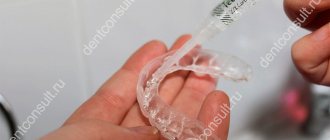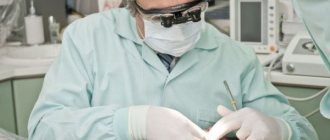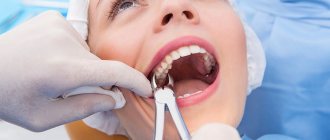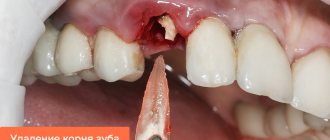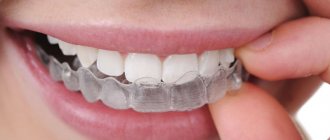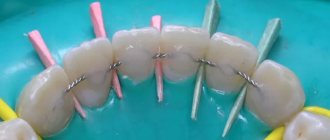What are the dangers of periodontitis and periodontal disease for a patient?
- inflammation of the ligaments of the teeth and nearby bone tissue,
- formation of voluminous gum pockets,
- loss or contraction of the gums, as a result - exposure of the roots of the teeth, which is fraught with increased sensitivity and an increased risk of developing caries,
- accumulation of a large amount of dental plaque,
- bad breath due to rotting food debris and plaque deep in the pockets,
- gum recession and root exposure,
- development of periodontitis - formation of cysts and granulomas on the roots of teeth,
- violation of the aesthetics of the dentition - due to the absence of teeth, changes in their shade and the appearance of gaps in the root area,
- mobility and loss of teeth.
But, unfortunately, inflammation is not limited to just one oral cavity. Periodontitis leads to many problems throughout the body - disruption of the gastrointestinal tract (which is logical, since along with food we swallow pathological microorganisms that are in the oral cavity), pathologies of the cardiovascular system and even kidneys! Read more in the article “The nature and dangers of periodontitis”
Just 10 years ago, periodontitis was an incurable disease. Medicine was unaware of methods for relieving inflammation and restoring periodontal ligaments to reduce the depth of periodontal pockets. All measures were aimed only at improving hygiene to stop the inflammatory process and slow down the progression of periodontitis. At the same time, the depth of the periodontal pocket did not decrease and, with poor hygiene, the disease took hold.
Why is it impossible to carry out implantation according to the classical protocol in case of periodontal disease?
The described diagnosis leads to inflammation and destruction of bone tissue. In places where teeth have already fallen out, the bone quickly atrophies and dissolves, becoming very thin. Because of this, it is almost impossible to implant an implant in a strictly specific area - there is simply nothing to hook it to.
Bone grafting for the described diagnosis often turns out to be ineffective. The maturation of bone tissue is very slow, so no one can guarantee that a titanium pin will be securely fixed in the jaw and will become a good support for a crown in the near future.
Having insisted on using the classical method, the patient should be prepared for the following complications:
- implant rejection;
- low stability of the implanted titanium root, which can lead to rapid failure of the prosthesis;
- severe inflammation of the gums (with periodontal disease, soft tissue infections are more often diagnosed).
Therefore, it is important to listen to the opinion of your doctor.
The vicious circle of periodontitis with tooth loss
Natural teeth require periodontal ligaments and a sufficient amount of bone tissue to be attached to the dentition. The habitat of the pathogenic flora of periodontitis is located around the tooth and leads to the destruction of these ligaments, bone and, as a result, to tooth loss. But if there is no tooth, then there is no environment for the development of the disease.
At the same time, a violation of the integrity of the dentition contributes to the development of periodontitis, since without chewing load the bone in the area of the missing tooth atrophies (decreases in volume), the neighboring teeth, under pressure and due to excessive load, “working for two”, gradually shift into the area of empty space. Thus, gaps form between the teeth, periodontal ligaments stretch and weaken, periodontal pockets increase and the disease becomes aggressive.
Restoring lost teeth using traditional methods - bridges supported by your teeth or removable dentures - only aggravates the situation. Removable dentures do not transfer the load to the bone, but compact it even more. They are attached with clasps to adjacent teeth and, against the background of developing atrophy, lose their fixation and damage (rub) soft tissues when chewing.
Dental bridges require grinding of your own teeth to secure them - this is already harmful and a long-term death sentence. Bone atrophy in the area of the missing tooth, which is camouflaged by the bridge crown, continues, the gums sag, microbes and food debris accumulate under the intermediate crown - the habitat of periodontitis. The supporting teeth shift and eventually the structure of the entire bridge breaks, and along with it the patient loses the supporting teeth.
In advanced stages, treatment of periodontitis, even using the latest treatment methods, is ineffective and sometimes the only way to stop the inflammatory process is to remove the affected mobile teeth, as the disease begins to seriously harm the entire body. Therefore, it is very important, when identifying a diagnosis, not to abandon the situation, but to begin to fight the disease immediately.
Price
- Primary appointment (examination, consultation) with a dentist (special offer) 100001
For free
Promotion
- Nobel implant + turnkey zirconium crown
59 900 ₽
Promotion
- Straumann implant + turnkey zirconium crown
59 900 ₽
Promotion
- Prosthetics of all jaw teeth on 4 implants
149 900 ₽
Promotion
Periodontal disease and periodontitis are diseases of periodontal tissue that lead to premature tooth loss. Restoring the dentition using implantation involves introducing implants (artificial roots) into the jawbone and installing crowns or dentures on them. In case of pathology of periodontal tissues, implantation is possible, but it is carried out with some peculiarities.
Implantation is the only effective way
Implants are screwed into the bone and do not require periodontal ligaments to secure them. The surface of the necks of special implants is resistant to the accumulation of microbes. Thus, dental implantation is the only effective way to restore teeth in conditions of periodontitis , but only if the disease is stopped . The patient gets rid of chronic periodontitis, the periodontal ligaments are restored, and the soft tissues are strengthened, remodeled and, with good hygiene, serve as a natural barrier to the penetration of infection into the bone.
The integrity of the dentition and proper distribution of the chewing load contributes to:
- stimulating blood circulation and normalizing nutrition of bone and gum cells,
- stops uneven distribution of chewing load and overload of teeth,
- prevents changes in bite and tooth mobility.
Implants should not be installed near teeth affected by periodontitis. If the remaining teeth, as the main source of “infection,” are left without complex therapy, then the development of infection will lead to an attack by pathogenic microflora on nearby implants and the soft tissue around them, and this will lead to complications and even rejection. Therefore, first of all, before implantation, you need to undergo a comprehensive course of periodontitis treatment and reduce the risks.
BE CAREFUL! Some unscrupulous and inexperienced doctors convince patients to place implants next to adjacent teeth affected by periodontitis, without informing them of the danger and essentially hoping for a “miracle.” Under no circumstances do this without simultaneous treatment and bringing periodontitis into a state of stable remission. Plus the realization that careful hygiene with this approach is very important in the future.
ON A NOTE! According to the American Association of Periodontists www.perio.org, the average age of a patient with periodontitis is 40+, 70% have implants in the oral cavity with developing complications.
With the development of microbiology and nanomaterials, drugs have been developed that not only stably stop the disease for many years, but also make it possible to restore the consequences of complex forms of periodontitis up to 80% in 1 year. Today, advanced dentistry has effective tools for preserving teeth. Smile recovery periodontal complexes are aimed initially at eliminating the environment for the development of the disease, and then enriching the affected areas with active growth factors to create a favorable environment for the natural regeneration of the patient’s cells and tissues.
Deep cleaning of periodontal pockets and 1-2 procedures will not stop the progression of the disease. Periodontitis is a multifaceted disease with an individual pathogenic flora for each patient and it must be treated accordingly, using a set of antibacterial and restorative measures, selected individually after a thorough study of microflora culture from periodontal pockets, drawing up a periodontogram, analyzing the state of bone tissue using computed tomography and additional blood tests.
Do you want to save your teeth and stop the disease? Smile recovery periodontal complexes that really work.
find your solution
Preparatory procedure
If it is necessary to install even one implant in a generalized process around the remaining teeth, it is necessary to carry out thorough preparation - periodontal hygiene of the oral cavity. An experienced periodontist surgeon will remove all supra- and subgingival deposits, select hygiene products - special brushes and medicated pastes, and, if necessary, prescribe medications. It is important to stabilize the process and stop the destruction of bone and soft tissue. Preliminary treatment before implantation in case of periodontitis is very important, it cannot be neglected - with hygiene, the doctor will remove foci of infection that can harm the implant. It should be noted that with careful preparation of the oral cavity and the correct choice of treatment plan, the risk of complications is minimal.
Features of dental implantation for periodontitis
First of all, in order to save the remaining teeth, the patient must accept the fact that he needs to undergo a fairly long course of treatment, usually 1 year. After all, the periodontal and bone ligaments need to recover, and this is not a quick process. Simply placing implants for periodontitis is a bad idea, since the conditions are unfavorable:
- there is atrophy and loosening of bone tissue,
- implants are poorly fixed in the inflamed bone,
- after installation, implants are surrounded by inflamed tissue, which can lead to disruption of their fixation and subsequent rejection,
- bone growth is difficult - in the presence of inflammation, the grafted material may not take root.
The good news is that thanks to periodontal complexes under the supervision of a periodontist, it is possible to put early and moderate periodontitis (stages I and II) into a state of stable long-term remission while simultaneously restoring missing teeth. The bad news is for those who have been diagnosed with acute forms and advanced stages, when there is tooth loss or mobility - removing all teeth and replacing them with implants is the most effective option. If the initial situation allows you to combine the procedures, the implants will be installed simultaneously - in the sockets of the extracted teeth.
What patients say about treatment
Nadezhda Aleksandrovna Selfie and review after implantation of all teeth, including the use of zygomatic implants
Mikhail Evgenievich With words of gratitude for the new smile! One year after basal implantation
Natalya Vladimirovna 1.5 years after all-on-4 implantation: re-prosthetics
Larisa Valentinovna Selfie with doctors after complex all-on-4 implantation
Olga Vyacheslavovna 10 months after all-on-6 implantation – examination, correction and hygiene
— Selfie and review after implantation of all teeth, including the use of zygomatic implants
With words of gratitude to the attending physicians - a review and photo after prosthetics using the all-on-4 technology: “Many thanks to Evgeniy Aleksandrovich for the excellent job done! Yuri Alexandrovich for his beautiful smile! May God bless you with health and prosperity. Happy New Year!"
Nadezhda Alexandrovna
Selfie and review after implantation of all teeth, including the use of zygomatic implants
Doctor: Sambuev B.S.
Specialization: Orthopedic dentist Experience: 11+
Doctor: Zhilenko E.A.
Specialization: Implant surgeon, periodontist, orthopedist Experience: 18+
Doctor: Bakaryan S.M.
Specialization: Orthopedic dentist Experience: 5+
3 days
View all reviews
— With words of gratitude for the new smile! One year after basal implantation
After basal dental implantation in the upper and lower jaws, as well as after subsequent re-prosthetics (changing the denture to a permanent structure). In the photo - with the attending physicians: orthopedic dentist Stanislav Chorny, as well as implant surgeon Nikolai Namdakov.
Mikhail Evgenievich
With words of gratitude for a new smile! One year after basal implantation
Doctor: Namdakov N.V.
Specialization: Maxillofacial surgeon, implantologist, orthopedist Experience: 18+
Doctor: Chorny S.V.
Specialization: Orthopedic dentist Experience: 20+
3 days
View all reviews
— 1.5 years after all-on-4 implantation: re-prosthetics
With orthopedic dentist Zhargal Dulgarov after changing the adaptive prosthesis to a permanent one. The patient began treatment in our clinic in May 2022. During this time, all-on-4 implantation was performed on original Nobel Biocare implants with immediate and delayed loading. A permanent prosthesis was installed on one jaw in November, now it’s time to re-prosthetize the second jaw. The patient chose a comfortable option made of ceramic composite – a durable and very aesthetic material.
Natalya Vladimirovna
1.5 years after all-on-4 implantation: re-prosthetics
Doctor: Dulgarov Zh.G.
Specialization: Orthopedic dentist, therapist Experience: 8+
3 days
View all reviews
— Selfie with doctors after complex all-on-4 implantation
With the attending physicians who performed dental prosthetics as part of complex all-on-4 implantation. With the installation of a fixed prosthesis immediately. As part of the implantation, implants original to this protocol were used - from Nobel Biocare.
Larisa Valentinovna
Selfie with doctors after complex all-on-4 implantation
Doctor: Dulgarov Zh.G.
Specialization: Orthopedic dentist, therapist Experience: 8+
3 days
View all reviews
— 10 months after all-on-6 implantation – examination, correction and hygiene
With words of gratitude for a new smile and a new life! After implantation of the upper jaw according to the all-on-6 protocol with immediate installation of a fixed denture within up to 3 days. With the attending doctors: maxillofacial surgeon, implantologist Nikolai Namdakov, orthopedic dentist Stanislav Chorny, as well as hygienist Sona Bakarian after a comprehensive cleaning of the oral cavity as part of a free service.
Olga Vyacheslavovna
10 months after all-on-6 implantation – examination, correction and hygiene
Doctor: Namdakov N.V.
Specialization: Maxillofacial surgeon, implantologist, orthopedist Experience: 18+
Doctor: Chorny S.V.
Specialization: Orthopedic dentist Experience: 20+
Doctor: Bakaryan S.M.
Specialization: Orthopedic dentist Experience: 5+
3 days
View all reviews
Features of basal implantation
This type of prosthetics is the least reliable. The service life of the basal implant is more than 5 years
Disadvantages: high cost, extended requirements for the qualifications of a doctor.
In Moscow, many dentists successfully cope with implantation tasks. Dentistry AcademyDent guarantees the quality and reliability of implants for patients of all ages in the absence of serious contraindications.
Reasons for refusing implantation may include:
- mental disorders;
— oncology;
- severe heart disease;
- pregnancy.
Basal root implants differ from classic ones in their greater length and integrity of the structure along with the abutment. The angle of inclination of the platform under the prosthesis can be changed, which allows you to select the strongest areas of the bone and increases the area of contact of the implant with its surface. But achieving aesthetics with basal implantation is very difficult.
If all teeth are removed or lost, implantation can be carried out according to several schemes: four, six or twelve units of implants. On their basis, a permanent prosthesis is placed, which allows to reduce the recovery time after the procedure.
In order to get excellent results, implants from trusted manufacturers are installed for periodontitis: Nobel Biocare, Astra tech, INNO.
Not all implants can be installed for periodontitis
In addition to therapy against periodontitis, it is important to choose the right implants. They must have high primary stability in the current unfavorable conditions and have a special coating to improve integration, both with the soft tissue of the gums and with various types of bone tissue. The surfaces of these implants at the level of contact with the gums have properties of resistance to the accumulation of microbes.
In the world, there are only 3 implantation systems, Nobel Biocare, Straumann, Oneway Biomed, which have been studied for more than 40 years, the implants of which take root and are not rejected in conditions of periodontitis. Naturally, provided that foci of infection are eliminated, complex treatment and rehabilitation of the affected tissues are completed.
Nobel Biocare® - Xeal® and TiUltra® Surfaces The intimate contact between the soft tissue and the abutment creates a barrier that protects the underlying bone and ensures long-term stability and healthy gum tissue.
It is a smooth, non-porous, nanostructured anodized surface with a chemical composition and topography designed specifically to enhance soft tissue attachment.
When developing these surfaces, scientists relied on 20 years of research into the effectiveness of anodized implants and laboratory results.
The single orthopedic surface of On1 eliminates the need for surgical manipulation of soft tissues during subsequent prosthetics.
The main objectives of these surfaces are to ensure a favorable outcome of implantation in the long term and reduce the incidence of re-implantitis.
More details
Straumann® Roxolid SlActive - Tissue Level Straumann® Tissue Levels have a smooth milled neck, which simplifies the manipulation of soft tissues and eliminates the need for the use of healing abutments during subsequent prosthetics. In the event of a slight recession of the soft tissue, the polished neck of the implant will protect the surface of the implant from the accumulation of microbes.
Nanostructures on the implant surface promote early osseointegration and a larger area of bone penetration.
The SLActive® surface is characterized by an increased anti-inflammatory response during the early healing stage. The results of world studies have confirmed the exceptional survival rate of implants in difficult clinical situations and when using aggressive treatment protocols: in patients with diabetes mellitus, after chemotherapy and radiation therapy, in heavy smokers, in patients with chronic periodontitis.
More details
OneWay Biomed® - antimicrobial coating BCS MU and Zygomatic implants are one-piece structures designed for osteofixation in the deep parts of the maxillofacial bone and cranial buttresses. For example, the bicortical plate, basal bone, zygomatic region, jaw tubercles, hyoid and mental bones, pterygoid process, etc.
Such implants do not require integration with the alveolar bone of the jaw, since they are securely fixed in other, non-resorbable areas. Over time, the newly formed alveolar bone compacts around the implants, providing additional support.
The surface of the implants has an antimicrobial coating, which prevents plaque and bacteria from accumulating.
The implant and abutment are a single whole; after implantation, soft tissues are not subjected to additional surgical interventions at the prosthetic stage.
More details
In addition, it is important to minimize the number of surgical manipulations on soft tissues after implantation, therefore implants with a single orthopedic surface On1 installed at the soft tissue level are preferable. During subsequent prosthetics, the orthopedist does not injure the gums and does not create additional mechanical stress on the implant, essentially working “above the gum.” In addition, all components of the prosthesis must be bioinert, that is, not cause inflammatory reactions from surrounding tissues.
Scenarios for tooth restoration against the background of periodontitis
Remember that affected teeth are a source of infection. It is on them, on their porous surface, that a huge number of pathogenic microorganisms accumulate. If implants with an active surface are placed next to such teeth, even the most resistant ones, which contain chemical elements that contribute to the healing of bone cells (such as SLA-Active from Straumann and Ti-Ultra from Nobel Biocare), they still will not are able to cope with a massive attack from all sides and bone tissue atrophy.
PARTIAL IMPLANTATION WITH REMAINING TEETH
- the depth of periodontal pockets is less than 8 millimeters,
- local foci of inflammation, swelling and itching are observed,
- mobility of teeth I and II degrees,
- bone quality type II and III,
- no suppuration and periodontal abscesses,
- teeth are in satisfactory condition,
- healing potential is medium to high.
EXTRACTION OF ALL TEETH AND COMPLEX IMPLANTATION
- teeth in the oral cavity are affected by diseases,
- there is degree III mobility of the remaining teeth,
- formation of deep periodontal pockets of more than 8 millimeters,
- purulent discharge from periodontal pockets,
- exposure of the neck of the teeth,
- abundant hard dental deposits,
- healing potential is low,
- severe atrophy of bone tissue.
Vladimir Ivanovich, 62 years old
“I had a difficult situation - there were almost no teeth left, it was painful, it was difficult to eat, there was constant psychological discomfort from these problems. I went to the clinic and everything was done quickly, professionally and competently! Incredible work and stunning results that are hard to believe. But he's real! Thanks to the doctors for my new life!”
- forget about bad breath
- communicate without hesitation
- refuse complex, lengthy and expensive treatment of periodontitis
- start living without constant visits to the dentist WITHOUT LIMITATIONS
watch a video with the patient
On day 2-3, a fixed prosthesis with an elastic acrylic base is installed. It gently envelops the gums and does not cause pain at all, even in the presence of an inflammatory process. There remains a functional space between the base of the prosthesis and the gums, which allows for hygienic care, which is especially important in the presence of gum inflammation. In addition, a number of companies (for example, Oneway Biomed) are developing implants with a smooth polished neck and an antimicrobial coating, which prevents plaque accumulation in the presence of inflammatory processes in periodontal tissue2.
In addition to the presence of inflammation of periodontal tissues, women should also pay attention to the state of hormonal levels, and, if necessary, undergo additional examination by an endocrinologist. Read more about the features of dental implantation in women >>>
earlier
Now
Patient history
“I arrived on Thursday, and on Tuesday I was already able to talk, eat, drink and smile with MY OWN teeth. I was pleasantly surprised by the work. Honestly, I didn't expect this. Here I saw what real work is: just installing the prosthesis took at least 2 hours, the fit was perfect, down to the millimeter! Many thanks to the doctors!”
watch a video with the patient
What is periodontal disease - why are there risks?
Periodontal disease is characterized by systemic damage to periodontal tissues, which leads to impaired blood supply to the gums, exposure of the neck of teeth, and thinning of the bone interdental septa. The disease is relatively rare, occurring in 1-8% of cases. The reasons for the development have not been precisely established. There is a version that hereditary predisposition and systemic diseases (diabetes mellitus, vegetative-vascular dystonia, hypertension, atherosclerosis) play a major role.
With early periodontal disease, reliable dental stability is maintained. When the necks are exposed, gum pockets do not form, and there is no inflammation in the periodontal tissues. Tooth mobility appears at a severe stage and leads to their loss.
Stages of periodontal disease:
- At the mild stage, there is slight receding and redness of the gums. The tooth is securely fixed in the alveolus, but X-ray examination reveals initial atrophic changes in the bone. There are hard deposits in the neck area.
- At the middle stage of the disease, the gums become bluish and bleed. Interdental spaces of varying lengths and periodontal grooves up to 6 mm deep are formed. An x-ray shows destruction of the alveolar process.
- The severe stage is accompanied by tooth mobility in all directions. The necks of the teeth are exposed to half the length of the root and are covered with plaque. The interdental spaces actively expand, and sensitivity appears from all types of irritants. Thinning of the alveolar process by 1 cm, which is more than half the height of the root system.
- The fourth stage is characterized by 2/3 exposure of the necks. The alveolar process of the jaw is significantly atrophied, the tooth is held in the bone by the apex of the root. The gums become red and thicken.
Periodontal disease should not be confused with periodontitis. Periodontal disease is a non-infectious disease that is not accompanied by an inflammatory process.
Possible risks of implantation:
- insufficient stability of the structure in the bone;
- inflammation of tissue in the implant area (peri-implantitis);
- titanium root rejection.
Implantation options for periodontitis
Basal implantation – BASAL COMPLEX
Complex basal implantation is the main and most optimal method, which is used in the presence of acute or chronic inflammation of periodontal tissue.
To restore all teeth, 8 to 12 implants are used, which are evenly distributed along the row. A large number of supports in the form of implants allows you to more reliably fix the prosthesis and significantly extend its service life, even in the presence of bone tissue atrophy, as well as inflammatory processes of periodontal tissue. A fixed prosthesis is installed on the 3rd day. Read more about basal implantation technology >>>
All-on-6 technology
Prosthetics on six implants for periodontitis and periodontal disease, along with basal implantation, is used quite often, since 6 supports to support the prosthesis are quite sufficient even in the presence of tissue inflammation and bone tissue atrophy (but of moderate degree). The denture is installed immediately (within up to 3 days), which allows the patient to return to a full life.
Learn more about the all-on-6 protocol >>>
All-on-4 technology
This protocol involves the use of only four implants for full dental prosthetics. Its use is justified in the presence of inflammation of the initial or middle stage, that is, with slight atrophy of bone tissue. For prosthetics of the upper jaw, it is possible to use elongated zygomatic implants. The prosthesis is installed on the 3rd day.
Learn more about the all-on-4 protocol >>>
Zygomatic implantation
Included in all comprehensive solutions for complete edentulism. This approach uses zygomatic implants, the length of which reaches 6 cm. They are installed only on the upper jaw and use the zygomatic bone, which is not subject to inflammatory processes, for fixation. The fixed prosthesis is fixed for 1-3 days.
Read more about zygomatic implantation >>>
earlier
Now
Patient history
“I am very pleased with the result of the work. The amazing thing is that in 4 days, and not in 2 years, I got my full life and confidence back. And most importantly, I was given back the opportunity to smile, which I had long forgotten about. If they say that this is impossible, read, call, ask - here you will get any information!”
watch a video with the patient
Briefly about periodontal disease and periodontitis
The tissues surrounding the tooth and holding it in the dental sockets (alveoli) are called periodontium. They allow dental units to perform their functions and stay firmly in place. For a variety of reasons, a pathological inflammatory or degenerative process may begin in periodontal tissues. As a rule, in this case periodontitis or periodontal disease is diagnosed, respectively. You can read more about this in other articles on our online resource. It should be noted that any periodontal disease without proper treatment provokes a loss of jaw bone tissue. A lack of volume and (or) bone density is a contraindication for integrating an implant into it.
Important: dental network periodontists have extensive experience in treating periodontal disease and periodontitis. The use of effective treatment methods and the use of the latest equipment make it possible to solve the patient’s problem, regardless of its severity.
Disadvantages of implantation for periodontitis and periodontal disease
Dental implantation involves surgical intervention, which, against the background of the inflammatory process of periodontal tissues, can cause certain difficulties. In addition, even when using one-stage implantation methods, the risk of rejection of structures is still noticeably higher than when installing implants into healthy tissue. After the installation of implants, the patient himself must not only strictly follow all the doctor’s instructions, but also carefully carry out hygiene procedures: not only in the morning and evening, but also after each meal. This is extremely important to ensure that as little harmful bacteria as possible remain in the oral cavity, which will cause inflammation of periodontal tissue.
“Inflammatory processes of periodontal tissues, as a rule, spread throughout the entire dentition, so a comprehensive solution to the problem is required. For periodontitis and periodontal disease, the only possible solution is one-stage implantation with immediate loading. The method uses one-piece implants that are fixed in the deep layers of bone tissue. Such sections are not subject to either atrophy or inflammatory processes. That is why the installation of implants is possible when periodontal tissue is destroyed.”
Bespalov Roman Dmitrievich, maxillofacial surgeon, implantologist, work experience of more than 26 years make an appointment
Types of prosthetics for gum disease
The following modern implantation methods are distinguished:
- classic;
— mini-implantation;
- basal.
The classic method of implantation is carried out in two stages. First, a titanium pin is mounted into the spongy tissue of the alveolar processes, which takes 3-6 months to heal. At the second stage, temporary or permanent crowns are attached.
In cases of severe osteoporosis of the jaw, osteoplasty is indicated for reliable integration of the metal root attachment of the implant with living tissues.
Disadvantages of this method:
— duration of the procedure and recovery period;
— unreliability of prostheses in case of severe degradation of the bone mass;
- high risk of complications in the generalized form of periodontal disease.
Mini-implantation is a variation of the classic method with the difference that it is used for teeth that do not experience significant stress. The basis of the prosthesis is a screw system fixed in the jaw. It is installed quickly, the rehabilitation period takes several weeks. Disadvantage of the method: not recommended for chewing teeth.
The least popular for periodontal disease is basal implantation, during which a screw metal “root” is introduced into the deep layers of the jaw, which are least susceptible to degenerative phenomena.
Are alternatives possible?
In case of inflammation of periodontal tissue, two-stage implantation is not recommended due to the fact that implants with this approach are installed in the central part of the bone tissue, which is most susceptible to inflammatory processes. This means there is a high risk of developing complications and rejection of structures. It will also not be possible to install a dental bridge - there is a high probability that the teeth remaining in the oral cavity will begin to loosen after some time. This will lead to mobility of the bridge and breakdown of the entire system.
In case of partial edentia and at the same time mobile teeth that are in a relatively healthy condition, the problem can be solved by installing a clasp denture. It has a metal base, which will allow you to secure the position of loose teeth and at the same time provide prosthetics for lost ones.
If there is acute inflammation that extends to most or all of the dentition, you may consider installing a removable soft plastic denture. At least for the duration of the acute stage of inflammation.
1 According to the World Health Organization (WHO). 2 According to official clinical trial data from Oneway Biomed.
Options for implant-supported dentures for periodontal disease and periodontitis
There are several options for dental prosthetics that can be used to restore lost teeth using implantation technology. The choice depends on the number of elements to be restored. If one dental unit is missing, then one implant is integrated and one crown is placed on it. If there are not several elements in a row, then two or three titanium rods are implanted and a bridge-like prosthetic structure is installed. In case of complete edentia (all teeth are missing), from 3 to 10 implants are fixed and a complete jaw prosthesis is placed on them. The orthopedic structure in this case can be fixed, removable or conditionally removable. If dental implantation is not possible, experts recommend basal implantation. This method involves the integration of titanium rods into deeper bone layers - into the basal ones.
Note: integration of implants for periodontal problems is most often carried out using a one-step protocol, i.e. removal of a non-viable tooth and simultaneous installation of an implant. The specialists of the “Smile” network of clinics are proficient in all implantation technologies; our branches are equipped with modern diagnostic equipment. You can be sure that our doctors will help you regardless of the complexity of your clinical case.
Algorithm for prosthetics using the implantation method for periodontal diseases
1 Diagnostics
Assessment of the clinical situation through visual and hardware examination. Identification of indications and contraindications, determination of the need for osteoplasty
2 Preparation
Sanitation of the oral cavity (treatment of teeth and gums, professional hygiene). If necessary, osteoplasty.
3 Implantation
Surgical operation to integrate implants into the patient, suturing the gums (with a two-stage protocol)
4 Osseointegration
Period of implantation of artificial roots
5 Dentures
Installation of a permanent prosthesis


